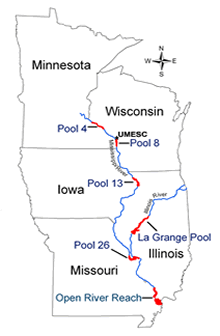 |
Upper Mississippi River Restoration ProgramLong Term Resource Monitoring |
|
 |
||
Background |
|
The Upper Mississippi River System (UMRS) is one of this nation's unique natural resources. It encompasses the commercially navigable reaches of the Upper Mississippi River, as well as the Illinois River and navigable portions of the Kaskaskia, Black, St. Croix and Minnesota Rivers. The ecosystem provides habitat to a wide array of fish and wildlife species distributed among a complex assortment of flowing channels, floodplain lakes, backwaters, wetlands, and floodplain forests. With an ecosystem as diverse and complex as the UMRS, many of its processes and their interrelationships are not well known. The Upper Mississippi River Restoration (UMRR) Program for the UMRS is first comprehensive program for ecosystem restoration, scientific research, and monitoring on a large river system in the Nation and the world. The research and monitoring are executed through the Long Term Resource Monitoring (LTRM) element, and the restoration is completed under the Habitat Rehabilitation and Enhancement Projects element. The UMRR was first authorized in Section 1103 of the Water Resources Development Act of 1986. UMRR has made significant contributions to advancing Congress' vision of the Upper Mississippi River System as "a nationally significant ecosystem and a nationally significant commercial navigation system," yet there are still many outstanding restoration and information needs. One way to help understand this multifaceted system is through environmental monitoring and research. The LTRM, the research and monitoring component of UMRR, combines environmental monitoring, research, systemic data acquisition, and modeling in an effort to provide a solid scientific foundation upon which the U.S. Army Corps of Engineers, the Upper Mississippi River Restoration Coordinating Committee (UMRR-CC), and many others base management actions and develop environmental policy on the Upper Mississippi River System. Data gathering, analysis, and dissemination are all key elements of the LTRM. The purpose of the LTRM web site is to provide scientifically sound information on the UMRS. This is achieved by offering the data and information generated by the LTRM in a variety of ways - database download tools, graphical interfaces, and reports - to make the LTRM data more accessible. The LTRM information is used extensively by natural resource managers, planners, administrators, scientists, academics, legislators, and the general public for improved understanding, problem solving, and informed decision-making about the issues important to the UMRS. The U.S. Army Corps of Engineers provides overall Program leadership responsibility and funding for the LTRM. The LTRM is implemented by the U.S. Geological Survey (USGS) in cooperation with the five UMRS states; Illinois, Iowa, Minnesota, Missouri, and Wisconsin. |
Page Last Modified: October 28, 2020



